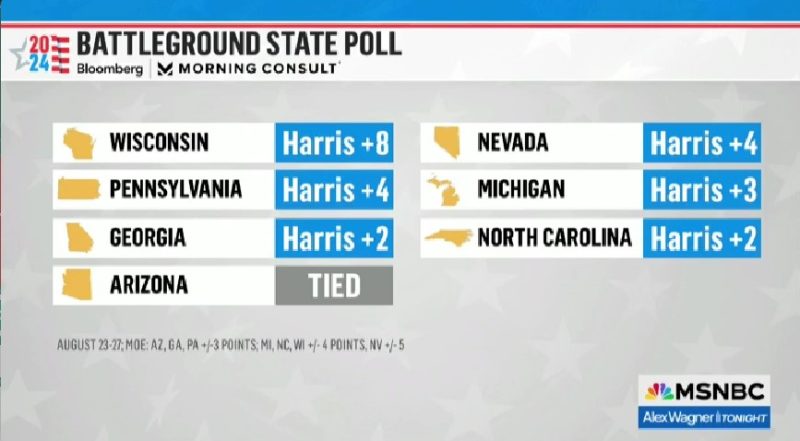
Vice President Kamala Harris is gaining ground in the 2024 presidential race, showing significant leads in several critical battleground states against former President Donald Trump.
According to a recent Bloomberg/Morning Consult poll conducted from August 23-27, Harris’s campaign is gaining momentum in states crucial for securing an electoral victory.
Polling Breakdown
- Wisconsin: Harris leads by 8 points. This substantial lead in a state known for its razor-thin margins signals strong voter support for Harris, possibly reflecting dissatisfaction with Trump’s previous term and alignment with Harris’s policy priorities.
- Pennsylvania and Nevada: Harris is up by 4 points in each of these states. Both Pennsylvania and Nevada have diverse electorates that have swung between parties in recent elections. Harris’s emphasis on issues like healthcare, economic stability, and social justice may be resonating with these voters, contributing to her lead.
- Michigan: With Harris ahead by 3 points, Michigan remains a contested ground. The state’s industrial base and working-class voters are crucial for both candidates, making Harris’s slight lead here indicative of her campaign’s targeted appeal.
- Georgia and North Carolina: Harris holds a slim 2-point lead in both states. Georgia’s transformation into a battleground state in recent years, fueled by demographic changes and voter mobilization efforts, suggests Harris’s campaign strategies are working. In North Carolina, a traditionally Republican stronghold, Harris’s competitive edge highlights a shifting political landscape.
- Arizona: Currently tied, Arizona remains a fiercely contested state. Both Harris and Trump are investing heavily in this state, understanding its potential to tip the scales in the electoral college. Arizona’s mixed demographic, including a growing Hispanic population, makes it a critical focus for campaign efforts.
Implications for the 2024 Election
Harris’s performance in these battleground states could have profound implications for the overall outcome of the 2024 election. With her leading or tying in states that were pivotal in the 2016 and 2020 elections, her campaign’s strategy to appeal to a broad coalition of voters appears to be paying off. Her focus on issues such as healthcare, women’s rights, economic recovery, and climate change seems to be resonating with voters who are looking for a continuation of the policies introduced during the Biden administration.
However, the race remains tight, with narrow leads in several states and a tied contest in Arizona. The volatility of voter sentiment means that both campaigns must continue to engage with and address the concerns of key demographic groups, including suburban voters, women, and minority communities, to secure their support.
Strategic Insights
For Harris to maintain and expand her lead, her campaign must continue its targeted outreach efforts, particularly in suburban and urban areas, where her policies on healthcare, education, and social justice issues have found considerable support. The focus should also be on solidifying her base while reaching out to undecided voters who could be swayed by specific policy proposals or by concerns about Trump’s potential return to office.
On the other hand, Trump’s campaign will likely intensify efforts in these battleground states by focusing on economic issues, immigration, and national security, aiming to recapture the support that propelled him to victory in 2016. His rallies and media appearances will aim to energize his base and attract swing voters by contrasting his vision with that of the current administration.
Conclusion
As the 2024 presidential race unfolds, these battleground states will be closely watched, serving as barometers for the nation’s political climate. Harris’s surge in the polls reflects her campaign’s ability to connect with voters’ concerns and aspirations. Still, with several months to go before Election Day, the dynamics could shift, making every strategic decision and campaign message crucial in the race for the White House. The coming weeks will be pivotal as both candidates refine their messages and ramp up their efforts to win over voters in these decisive states.
